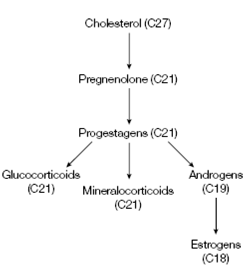Steroid hormones:
Cholesterol is the precursor of the five main classes of steroid hormones shown in the above Table. The synthesis of steroid hormones is initiated through the removal of a six-carbon unit from carbon 20 of the cholesterol side chain to form pregnenolone, the ordinary precursor of all steroid hormones. A series of reactions catalyzed through cytochrome P450 change pregnenolone to provide increase to the individual hormones.
The cytochrome P450s are a group of heme-containing enzymes which get their name from the wavelength maximum of their absorbance spectra when bound to carbon monoxide. They are there in both the mitochondria and the SER of several cells, and consist of a family of structurally related enzymes with various substrate specificities. Enzymes all catalyze so-called mono-oxygenase reactions, in that one oxygen atom from molecular oxygen is inserted into the substrate molecule and the other oxygen atom builts water. The electrons needs to bring about the decrement of oxygen to form water are supplied through specialized electron transport chains that are functionally linked to the P450 enzymes. These electron transport chains commonly have NADPH as the ultimate electron donor so a cytochrome P450-catalyzed reaction is frequently characterized through the involvement of both NADPH and O2.

Figure: Biosynthetic pathway for the synthesis of the steroid hormones.